Galtar lighthouse
On Keflavíkurhól between Galtar by Súgandafjörður and Skálavíkur, the first lighthouse was built in 1920. It was made according to the same design as Svalvoga Lighthouse.
In 1959, a new lighthouse was built because the old one was considered too low. The designer is engineer Eggert Steinsen. The lighthouse is 10.7 m high and built of concrete.
Energy for lighthouse lighting was obtained from light engines and from the 1960s also from a small hydroelectric station. In 1994, the lighthouse was electrified with solar energy and wind generators.
View
Hornbjargs lighthouse
Hornbjarg lighthouse was built in 1930 in Látravík, east of Hornbjarg. The lighthouse is 10.2 m high. The designer is engineer Benedikt Jónasson. It was lit with gas lamps until the 1960s, but then it was electrically lit with energy from a small hydroelectric station and light engines. In 1995, it was electrified with solar and wind energy and an automatic weather observatory was installed.
View
Selskers lighthouse
Selskersviti is on the peninsula of the same name out of Ófeigsfjörður. It was built in 1943 from concrete. The lighthouse was not commissioned until 1947. It is 18.4 m high. The designer is engineer Axel Sveinsson. The lighthouse was lit by gas lamps until 1992 when it was electrified by solar energy.
View
Langanes lighthouse in Arnarfjordur
Langanesviti in Arnarfjörður was built in 1949. The designer is engineer Axel Sveinsson. The lighthouse is a concrete oblong rectangle. It is 2.5 m wide, 5 m long and 4.8 m high.
Gas equipment was in the lighthouse until 1993, but then it was electrified with solar energy.
View
Sléttueyrar lighthouse
Sléttunesviti is on Sléttunes north of the mouth of Jökulfjörður. It was built in 1949 and is 4.85 m high. The designer is engineer Axel Sveinsson.
It was lit with gas lamps until 1993, when it was electrified with solar energy.
View
Hólmavíkur lighthouse
Hólmavík lighthouse was built in 1914. In the first decade, the lighthouse had a small kerosene lamp, equipped with a cover that turned for the light due to the heat from the lamp and flashed the light and became easily recognizable from other lights. In 1925, the lighthouse was gasified and electrified in 1963. The lighthouse is 3 m high. Hannuiður is S.H. Lundh & Co. in Kristiania, Norway.
View
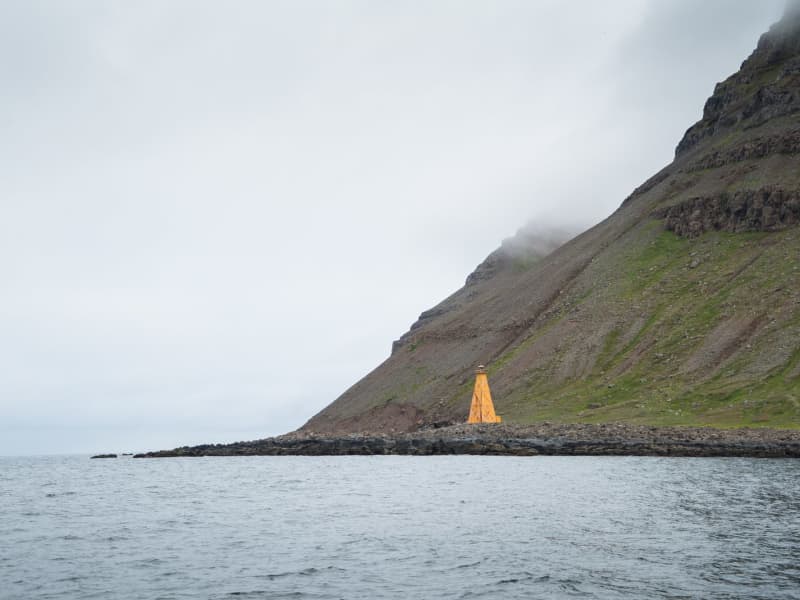
Straumnes lighthouse
In 1919, a 20 m high iron frame lighthouse was built on Straumnes, north of the mouth of Aðalvík, but the stranding of the ship Godafoss under Grænuhlíð in 1916 accelerated the construction of a lighthouse on Straumnes. By 1930, the iron frame had deteriorated and concrete was placed around it. In 1993 it was electrified with solar energy and in 1995 an automatic weather observatory was installed. The lighthouse is 23.3 m high. The designers are Thorvald Krabbe, Sigurður Thoroddsen, Benedikt Jónasson and Axel Sveinsson engineers.
View
Arnarnes lighthouse
In 1902, a lighthouse was built on Arnarnes, east of the mouth of Skutulsfjörður at Ísafjarðardjúp. The lighthouse was a wooden house. In 1921, an iron frame lighthouse was built to replace the old one. The new lighthouse used gas lamps until 1995 when batteries were installed. The lighthouse is 5.4 m high. The designer is engineer Thorvalde Krabbe.
View
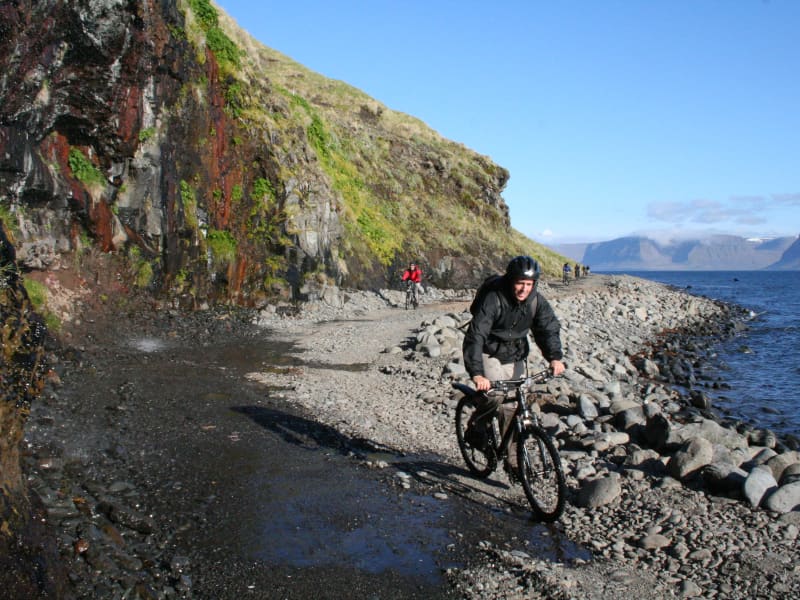
Svalvogar
Svalvogar is a 49-kilometre circular route between the fjords of Dýrafjörður and Arnarfjörður. It usually starts and finishes in Þingeyri and takes the narrow exposed coastal track around the headland (not to be attempted at high tide) and comes back along the Kaldbakur route, past the Westfjords’ tallest mountain in the so-called Westfjords Alps. Sometimes called the Dream Road, Svalvogar is among the most beautiful routes in the country. It is not suitable for small cars and is best enjoyed by mountain bike. Be prepared for a workout, or consider taking a 4x4 vehicle.
If passengers are afraid of heights, it's recommended to begin the route from Arnarfjörður and drive towards Dýrafjörður. This way, when passing another car, yours will be on the right side of the road, which is less intimidating than driving alongside the sea.
View
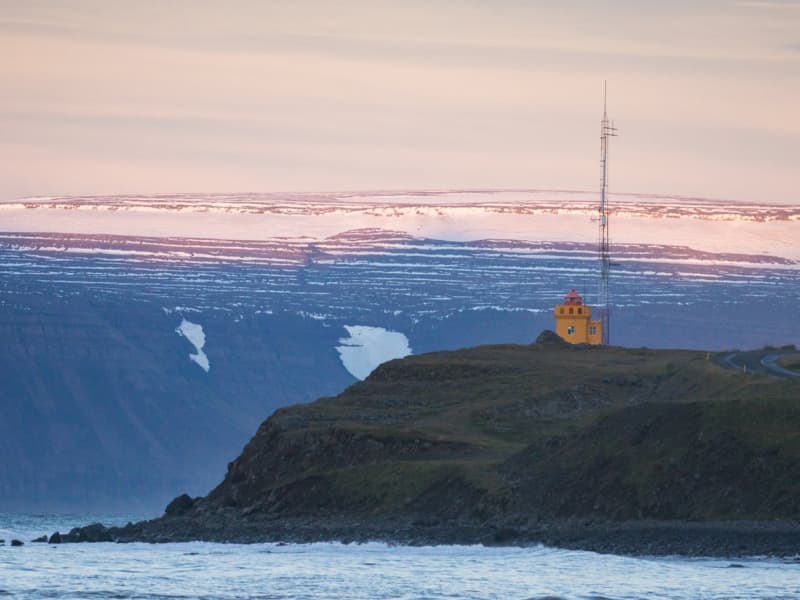
Óshóla lighthouse
The lighthouse was built in 1937 on Óshólur under Óshryna, at the far end of Óshlíð, inside Bolungarvík. It is 6.4 m high and made of concrete. The designer is engineer Benedikt Jónasson.
The lighthouse was electrified in 1964, but gas was used as a backup until 1995, when the gas equipment was removed and replaced by batteries connected to a spare bulb.
View
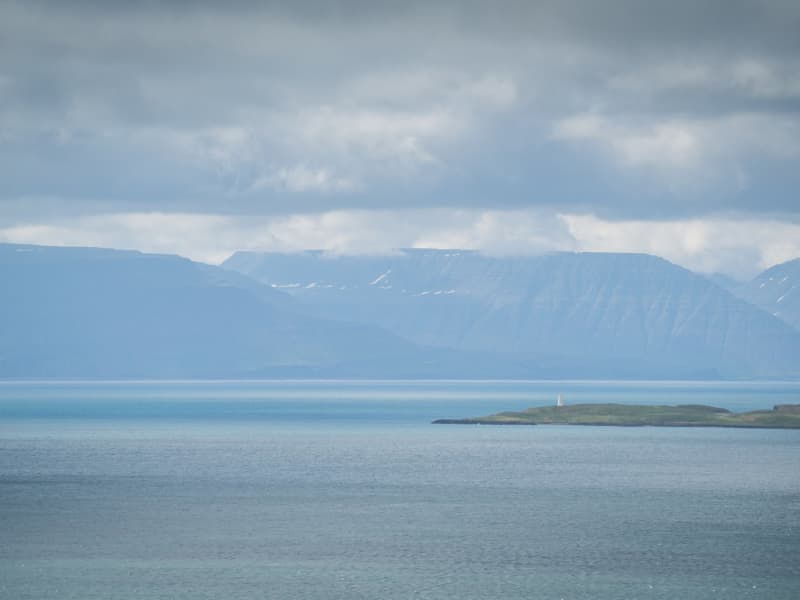
Æðeyjar lighthouse
Æðeyjarviti in Ísafjarðardjúpi was built in 1944 but was not put into use until 1949. It is made of concrete and is 12.8 m high. The designer is engineer Axel Sveinsson.
Old gaslights were installed in it to begin with, but new devices were installed in 1951. The lighthouse was electrified in 1988 and gaslights removed.
View
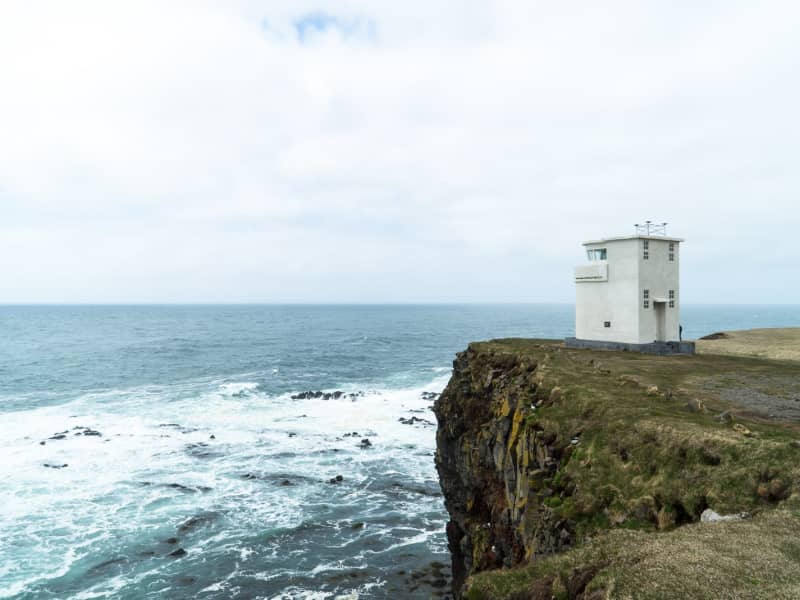
Bjargtanga lighthouse
A lighthouse was first built on Látrabjargi in 1913, but in 1948 a new lighthouse was built. It had a gas light fixture until it was electrified with energy from light engines. In 1985, utility electricity was brought in, but an automatic lighting machine provides back-up power in the event of a power outage. An automatic weather observation station was commissioned in 1995. The lighthouse is 5.9 m high. The designers are Axel Sveinsson, an engineer, and Einar Stefánsson, a house designer.
View

Ólafs light house
Ólafsviti lighthouse in Patreksfjörður is a lighthouse built in 1943 and taken into use in 1947. The lighthouse is a 14.4 m high concrete tower.
It was built according to plans by engineer Axel Sveinsson. Gaslight remained in the lighthouse until 1978, when it was electrified.
View
Malarhorns lighthouse
Construction of the lighthouse at Malarhorn first began in 1914 and was completed in 1915. But in 1948, a new lighthouse with gas lighting was built. The lighthouse was electrified in 1963, but gas was used as a backup until 1996. Then it was equipped with a backup bulb that receives energy from batteries. The lighthouse is 3 m high. The designer is Axel Sveinsson, an engineer, and Einar Stefánsson, a house designer.
View
Svalvoga lighthouse
Svalvogaviti stands on Hafnarnes at the far end of the tang between Arnarfjörður and Dýrafjörður. It was built in 1920. The designers are Thorvald Krabbe and Guðmundur j. Hlíðdal engineer.
The lighthouse is made of concrete, with square sides 2.7x2.7 m at the base and 3 m high.
The lighthouse was electrified in 1960 with current from a light machine that was at the lighthouse keeper's house in Svalvogur. In 1984, the lighthouse was again lit with gas, but on September 10, 1992, it was finally lit again with electricity and then with solar energy.
View
Kópanes lighthouse
Kópanesviti is in Kópanes, at the far end of the peninsula between Tálknafjörður and Arnarfjörður. It was built in 1971 and lit with gas lamps until it was electrified with solar energy in 1993. The lighthouse is 6.4 m high. The designer is engineer Aðalsteinn Júlíusson. There is a shelter for castaways at the lighthouse.
View
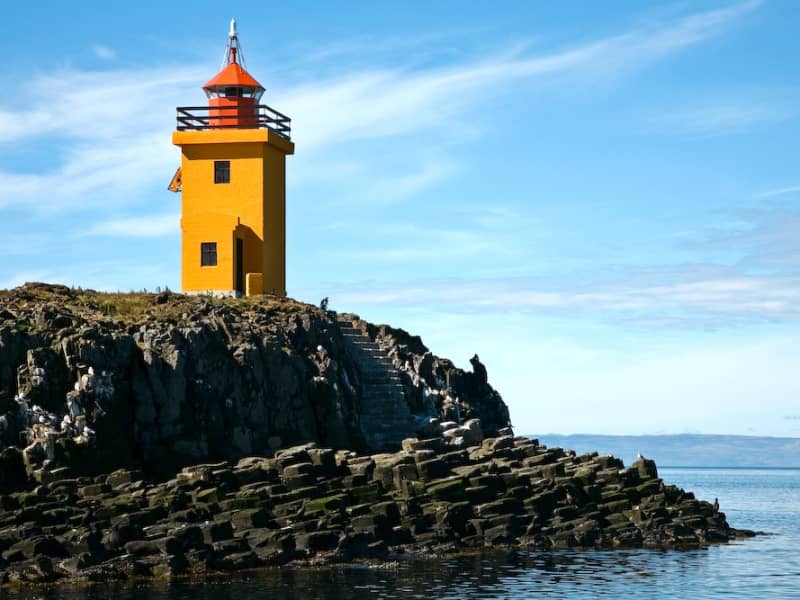
Klofningsviti lighthouse
Klofningi lighthouse is on the Klofningi ridge west of Flatey in Breiðafjörður. It was built in 1926. It was lit by gas lamps until it was electrified with solar energy in 1991. The lighthouse is 9.3 m high. The designer is engineer Benedikt Jónasson.
View
Fjallaskaga lighthouse
Fjallaskagaviti is at the mouth of Dýrafjörður. It was built in 1954 and it is 12.7 m high. The designer is engineer Axel Sveinsson. Three other lighthouses in the country are made according to the same design.
The lighthouse was electrified with solar energy on May 28, 1993.
View
Sauðanes lighthouse by Sugandafjord
Sauðanesviti is at the far end of the peninsula between Önundfjörður and Súgandafjörður. Norwegian fiberglass light house installed in 1964. Designer is DE-NO-FA A/S, Fredrikstad, Norway.
The lighthouse is 4.7 m high.
In 1991, the lighthouse was electrified with disposable batteries, but on June 25, 1999, a solar energy sensor was installed.
View
Grímseyjar lighthouse
Grímseyjarviti was built in 1949 and was lit with gas lamps. In 1992, it was electrified with solar energy. The lighthouse is 10.3 m high. The designer is Einar Stefánsson, a house designer.
View
Skorarviti lighthouse
Skorarviti is in the west under Stálfjall, north of Breiðafjörður. It was built in 1953, but the lighthouse was lit for the first time in 1954. The lighthouse was lit by gas lamps until it was electrified with solar energy in 1990. The lighthouse is 8.8 m high. The designer is engineer Axel Sveinsson.
On the front of the lighthouse, there is a plaque commemorating Eggert Ólafsson, deputy attorney general, naturalist and poet, and his wife, Ingibjörga Guðmundsdóttir, who on May 30, 1768 pushed from Skor out onto Breiðafjörður in their act of cowardice.
View
